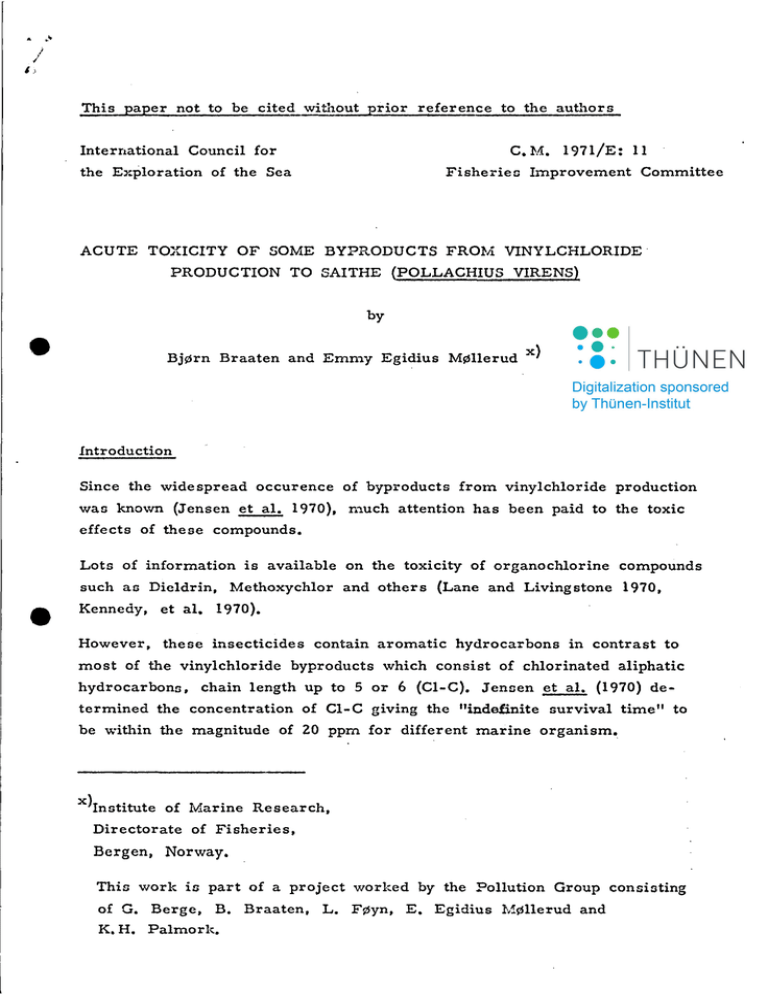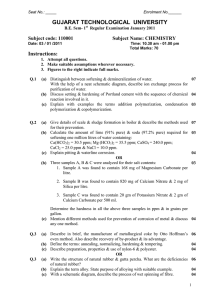1971/E:
advertisement

This paper not to be cited without prior reference to the auL'tors
C.?-.1. 1971/E: 11
Fisherieo Improvement Committee
International Council for
the Exploration of the Sea
ACUTE TOXICITY OF SOME BYPRODUCTS FROM VINYLCHLORIDE·
PRODUCTION TO SAITHE (POLLACHIUS VIRENS)
•
by
Bj~rn
Braaten and Emmy Egidius
M~l1erud x)
Introduction
Since the widespread occurence of byproducts from vinylchloride production
was kno...v n (Jensen et al. 1970), m.uch attention has been paid to the toxic
effects of these compounds.
Lots of information is available on the toxicity of organochlorine compounds
•
such as Dieldrin, Methoxychlor and others (Lane and Livingstone 1970,
Kennedy, et al. 1970)•
However, these insecticides contain aromatic hydrocarbons in contrast to
most of the vinylchloride byproducts which consist of chlorinated aliphatic
hydrocarbono, chain length up to 5
01'
6 (CI-C). Jencen et al. (1970) de-
termined the concentration of CI-C giving the "indefinite survival time" to
be within the magnitude of 20 ppm for different marine organism.
x}Institute of Marine Research,
Directorate of Fisheries,
Bergen, Norway.
This work in part of a project worked by the Pollution Group consioting
of G. Berge, B. Braaten, L. Fl1Syn, E. Egidius
K. H. Palmork.
:M:~llerud
and
,
- 2 -
The present investigatinn giveo some information of the aqute toxicity 01
I
vinylchloride waste producto on saithe and pollack (age group I' a~d II).
The recovery ability of the animals wao also studied.
Material and methods
The experimental an~als were polla<;k (Pollachius pollachius L.). and
saithe (Pollachius virens L.)
all caught in' the Bergen area of the Nor-
wegian west coast.
•
A prelirninary experiment was performed with pollack. in the remaining
tests saithe was used. Holding eonditions, aeelimation of the
pol1~ek
and
set up of the' preliminary experiment was similar to experiment no. 1
(ICES - C. M. 1971/E:I0). The mentioned paper also deseribes th'e handling
of saithc whieh was similar to the handling of eod (in experiment no. 2).
Two additional survival tests were aceomplished in 100 and 87 ppm respeetively using saithe eaught in May -71. In 'the survival test wlth 28
. ,r
ppm both fi'sh {rom Deeember -70 and May ~71 were used.
~
"
The saithe used. in the experiments had a length range from 19 to 28 cm
arid weight from 86 to 132 ? "ams.
•
The oval teat tanks (appr. 300 1) used {ar saithe were eoated wit~. a plastie
I
. ;
~
,:: ,
.:film aIl:d filled up with 210 1 of test solutions. The fiah were transferred
to the tanke three days prior to the tests started for acelimation in. eon'tinuouo nowing water.· Ten fish werc uscd in eaeh tank.
It would have been desirable to earry out the ,toxicity tests in eontinuous
flowing water. but due to the low solubility of the .toxie material in seawater~
the experiments had to be carried out in a statie system. The
50-
lutions were then aerated. Every day 140 I was tapped out of each tank
and replaeed by a freshly made solution. 'Water oamples for analysis were
taken before and after renewal.
In order to determine the medium lethal eoneentration, LD50, the coneentration values were aelected from a logaritmie scale (Doudoroff et al. 1951).
The following coneentrations were used: 100 - 87 - 75 - 65 - 56 - 49 42 - 37 - 32 and 28 ppm.
I
- 3 -
.:
Since renewal of test solutions was essential, a dayly variation: in tempera0
ture of 3 to 5 0 C was obtained during the experiments (range 9.5 to 12.5 C
in test 2 and ~ange 8.6 to 14.2
±2
0
/00,
in addtitional tests). Salinity ~as 34.6
0
/00
oxygen content was not measured. Air flowa were checked several
times daily and adjusted if neceasary, and control fishes were tested under
similar conditions.
The n'laterial tested' was waste products from Norwegian, ,.: nylc~loride production. A preliminary test was carried out on the crude waste' (EDC crude
waste), in the remaining experiments a distillate of the waste product (EDC
tar distillate) oI'.'litting the tar fractions were used. For details in chemical
•
compooition ofthe test material sec Jensen et al., in.prop.
Analysis were carried out on a Hewlett and Packard 700 Gas Chromatograph
fitted with an electron capture detector (nickel) and coupled to an Intorfionico
digital integrator (model CRS 100). A SF 96 (10 %) column waa used (Jensen
and Palmork, in ,prep. :.: .
Time to 50
0/., mortality and its 95 1<, confidence limits, were estimated for
each bioassay (experiment 2) by probit analysis (Litchfield 1949).
Resulta
For pollack a LD 50 va!t.ie bctween 50 and 100 ppm of EDC crude waste
•
within 24 hours was indicated (table I) •
Table I.
Per cent mortality of pollack cxposed to EDC crude waste.
Conc. (ppm)
time in hours
11I
6
z
24
300
100
200
100
150
100
100
0
100
50
0
0
0
10
10
0
0
0
0
1
0
,0
0
0
48
0
Bioassayo uoing saithe with thc EnC tar distillate gave approximately similar results within 24 houra, although variable results were encountered
(table 2). For exarnple, a higher LD50 value was obtained in 42 ppm
compared to the lower values in 37 and 32 ppm respectively.
Table 2.
Survival times of naithe exposed to EDC tar distillate in 96 hours.
b - additional test, C - eontrol.
Cone. (ppm)
Mortality in te st
%
100
1 - 2
100
100 (b)
ä
1
100
87
87 (b)
•
Time to 50 % mortality and
95 % eonfidcnce limits (hr)
1
3 - 4
5 (4, 6~)
100
100
75
28 (2 I, 37)
100
65
100
56
28 (25, 31)
49 (42, 56)
49
53 (40, 70)
80
42
70 (63,
77)
80
37
42 (34, 53)
70
32
57
50
28
C
100
20
0
Analyois of t11e water sanlples gave extrcmely variable results, the lowest
value wao uoually found after renewal of the tmde oolution. This can be
explained by accuming an incomplete mixing of water and tmdc compounds.
•
lt is most probable that some houre will elapse before thc solution is equili-
brated. However, abnormally high valuea were also iound aU'long tbe (lamplen.
indiCating water from tbe surface film in the sampie. A glosay film with a
ratber stift membrane was often observed on tbc aur!acc.
A teot-fiah in continuous motion mig11.t bc cxpooed to variable eoneentrations
tbe firnt period after renewal of t11.o toxie solution, depenc!ing on low solubility and incomplete mixing. The observed variation in temperature will
probably also influence on thc mortality. On this background a certain unexpected variance in the results aeems reasonable.
It must be emphasized that all concentrations used were based on weight/
volume. Earlier results (ICES - C. M. 1971/E:IO) chowed tL;'at the actual
concentrations in average were 2.5 times lower th-an expected. If the same
relationship exists in tbc· preoent matm.·ial. the actual LD50 will be elose
to 16 ppm, inetead of cc. 40 ppm.·
.... •
.:
- 5 An introductory experiment of tho ability to rocovor whon transforrod to
frosh sea-wator was porformcd. After two hours expooure in 100 ppm,
a11 ten fioh laid on the bottom. of the tank and only weak opercular movements were' seen. One lish waD then transferred to frcsh Dea-water. and
within 5 minutes it was able to
swir~'l.
spectively two and seven fish
were transferred to fresh sea-water. One
Vlith intervals of ton minutes rc-
of the t\vo' survived, but only one of thc remaining· seven started to swim.
A similar test was done in 87 ppm. After three hours all ten fish
were
taken into frech sea-water and six of them survived. [;ome of them eould
be eharaeterized as completc dead, but they still reeovered. Of thc three
rccovcred fish from the first and sb: from the last eJ:pcriment, all sccmed
•
to live quite normal for a week•
Diseussion and conc1usion.
The present data indieate that fairly high eoneentrations (about 40 ppm,
weißht/volume) are needed to eause acute toxicity on Gadidac of age group
land H. The rcsults are in eonformation with some prcliminary studies
reportcd by Berge, Lj~en and Palmork (1970) using 1. 2 diehloropropane,
a main eomponent from industrial container s found in the North Sea. On
the eontrary, the studies of Jensen et. al. (1970), showed that within the
same period of time (96 hr.), only 1/10 of thc coneentration was necessary
to produee a similar aeute effeet on eod. This great differcnce in suscepti";'
bility mißht partly be explained by spedes, and age differenees,
.
.
variabiliti~s
in ehemieal eomposition of the waste material, and finally different experi-'
mental eonditions, for example temperature. Further, it waG surprising to
see thatlarvae even seemed to be leGs suseeptible (leES - C.M. 1971/E:9,).~
Thc reasons for this findings are not. obvious, but rnight be due to a specHie
I
action of thc toxie material on eertain organs in the younß fish that is not
developed in the larva.
Sinee the aeute toxie cffeet to a grcat cxtent was reversible, this observation indieateo a toxication effeet of physieal nature (Crisp et. ale 1967).
The resulta also sugßest the poosibility of survival for fiah exposed temporarily to high eoneentrations if they are able to leave the toxie area. Still
nothing io known about the oublethal and ehronie cffeets caused by such an
exposuro or exposurcs to lower eoncentrations.
Abstract
1'11e survival of land II age group saithe and pollack in waste produ'cts
{rom Norwegian vinylchloride production was tested and time
mortality and 95
10
to 50 %
confidenee limits were .estimated. Recovery tests
on
.
,
apparently dead fish (100 and 87 ppm of the toxic substances were performed~
•
.
.
'
'
- 6,REFERENCES
Berge, G.,
Lj~en,
R. and Palmork, K. H., 1970.
Tbe disposal of con-
tainers with industrial waste into The North Sea: A problem to
fisheries. Paper presented to FAO Technical Conference on Marine
Pollution and its Effects on Living Resources and Fishing, Rome,
Italy, 9-13 December 1970, FIR:MP/70/R-73: 3p.
Crisp, D. J., Christie, A. O. and Ghobashy, A. F. G., 1967.
•
Narcotic and
toxic action of organic compounds on barnacle larvae. Comp. Bioehern. Physiol. 22, 629-649•
Doudoroff, P., Anderson, B.G., Burdie, G.E., Galtsoff, P.S., Hart, W.B ,
Patric, R., Strong, E.R., Surber, E.
-'lr.
and Van Horn, W.M., 1951.
Bio-assay methods for the evaluation of acute to,dcity of industrial
wastes to Hsh. Sewage ind. V{astes 2, 1330-1397.
I. C. E. S., C. M. 1971/E :9.
p.
Braaten, B., Egidius M~llerud, E., and Solemdal,
The influence of byproducts from vinylchloride production on
ferti1izatio~,
development and larval survival on plaice, cod and herring eggs.
,
Jensen, S.,
Jernel~v,
A.,
Lange. R. and Palmork, K. H., 1970. Chlorinated
by-producto from vinylchloride production: a new source of marine
pollution. Paper presented to FAO Technical Conference on Marine
•
Pollution and its Effects on Living Resources and Fishing. Rome,
Italy, 9-18 December. 1970. FIR:MP/70/E-88:8p.
Jensen, S. and Palmork. K. H., in prep.
Jensen, S.. Palmork, K. H. and Wilhelmsen. S., in prep.
Kennedy, H. D., Eller, L. L. and Walsh, D. F., 1970.
Chronic Effects of
Mcthoxychlor on Bluegills and Aquatic Invertebrates. Tech. pap. Bur ~
Sport Fish. and Wild. (US) 53 13 p.
Lane, C. E. and Livingston, R. J., 1970. Some Acute and Chronic Effects
of Dieldrin on the Sailfin Molly, Poecilia Latipinna. Trans. Am.
Fish. Soc. 99(3): 489-495.
Litchfield, J.T., 1949.
A method for rapid graphie solution of time-
per cent effect curves. J. Pharmac. exp. Ther. 97 399-408.



